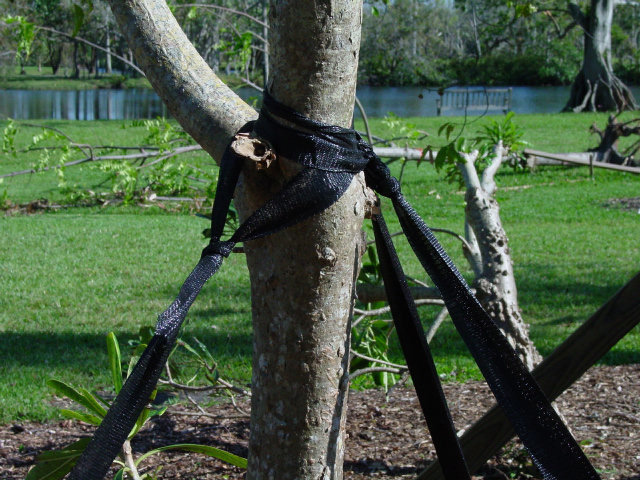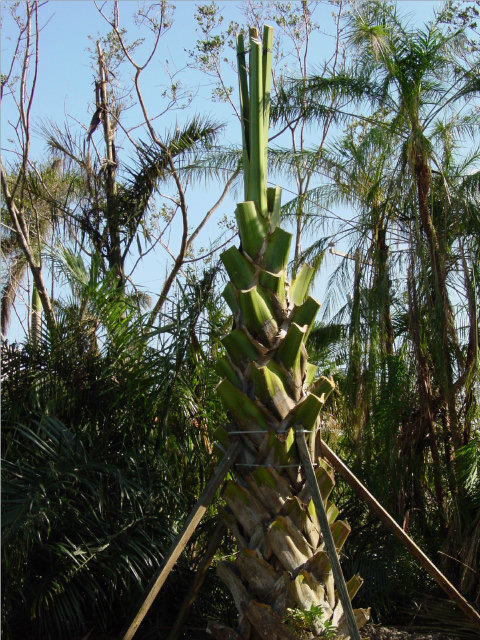Fixing Tree Damage After A Hurricane

As Published in the Miami Herald
Hurricane season ends Nov. 30, with the fiercest storms doing their damage from August to October. They often wreak terrible damage on South Florida trees and landscapes. The wreckage may make you feel helpless, but there are steps you can take to minimize the damage.
Trees that have been uprooted and toppled should be your first priority. First, determine whether it is worth the time, effort and money to rescue the downed tree.
If yes, then the tree should be reset using proper staking techniques and may need pruning of the canopy, as well as roots. A large woody tree such as a royal poinciana or a mango will have root damage from the fall and will require some canopy reduction in order to restore root loss and balance. A fallen palm does not need root pruning, but will benefit from light frond removal.
 |
| Larger trees damaged by tropical storm-force winds need to be reset using two-by-fours. |
Canopy pruning on woody trees should not be too severe, with a maximum of 30 percent being removed. Most cuts should be made back to the trunk or major branches. These thinning cuts remove weight from the canopy, which will allow the tree to stand more easily. Cuts made in the middle of a branch are known as heading cuts, and should be used to remove damaged or torn areas. Contact a certified arborist for major jobs.
For resetting a large tree, you will need two-by-fours and metal or nylon strapping to brace it. Large trees need between three to five braces spaced evenly around the tree. Cut several one-foot long two-by-fours to strap to the trunk at a height of about four to five feet, using metal or nylon strapping. These small pieces of wood allow the longer supports to be attached without putting a nail into the tree itself, which will damage the vascular system.
Eight-foot lengths of two-by-fours are then cut at a 45-degree angle and nailed into the wood strapped around the trunk of the tree. These long braces are what will hold the tree in place until its root system is properly anchored. The bottom of the braces should be hammered into the ground or placed in small pre-dug holes to keep them from slipping. Three to five braces should be evenly spaced around the tree.
 |
| Smaller trees damaged by strong wonds can be reset using strapping. |
Smaller trees should be held up using nylon strapping or rope tied around the trunk of the tree and attached to rebar driven into the ground. It is important that the straps are evenly placed around the trunk and that they are loosened as the tree begins to grow. If they are not loosened over time, they will girdle the tree and do major damage. Burlap should be placed around the trunk of the large and small trees before any strapping is put into place to prevent trunk damage.
Reset trees need to be on a watering schedule consistent with a newly planted tree. They can be fertilized with a liquid as soon as they are reset and placed on a granular fertilizer schedule once they have had one to two flushes of new leaves. Aftercare of hurricane-damaged trees must continue for years as the root system will take time to regrow to its former strength. Annual canopy thinning will also be needed to keep the trees from toppling in minor wind storms.
The bracing may be removed after a minimum of 10 to 12 months.
 |
| Palms that fall during a hurricane should be restaked and may be heavily pruned. |
Sometimes trees only sustain limb damage in the form of ripped, twisted or broken branches. These trees should be lightly pruned to remove the damaged wood. Make a clean cut below the break. The location of this cut depends on how you wish the tree to respond.
If you want the tree to branch at that spot, make a heading cut in the middle of the branch. If you simply want to remove the branch, make a thinning cut to the trunk or a major branch.
Pay attention to which trees did well in the storm and which did not. It may be necessary to rethink the design of your yard and to replant with strong native trees that will hold up well in a storm. Even a Category 1 can inflict major damage on weak trees.
Jeff Wasielewski is the Multimedia Specialist at Fairchild and a professor of horticulture at Miami Dade College.
